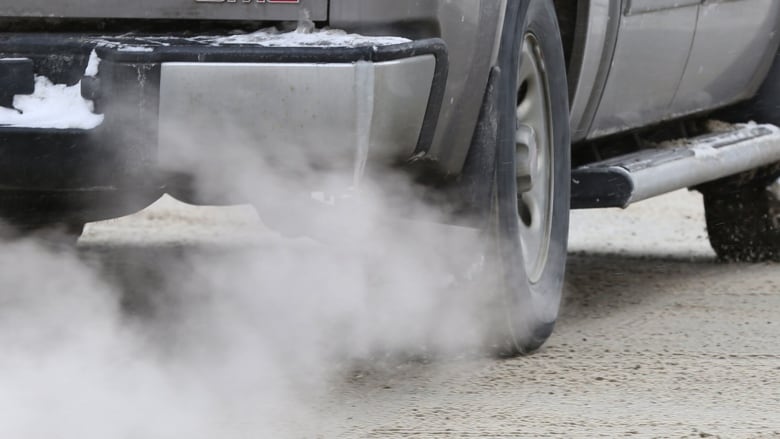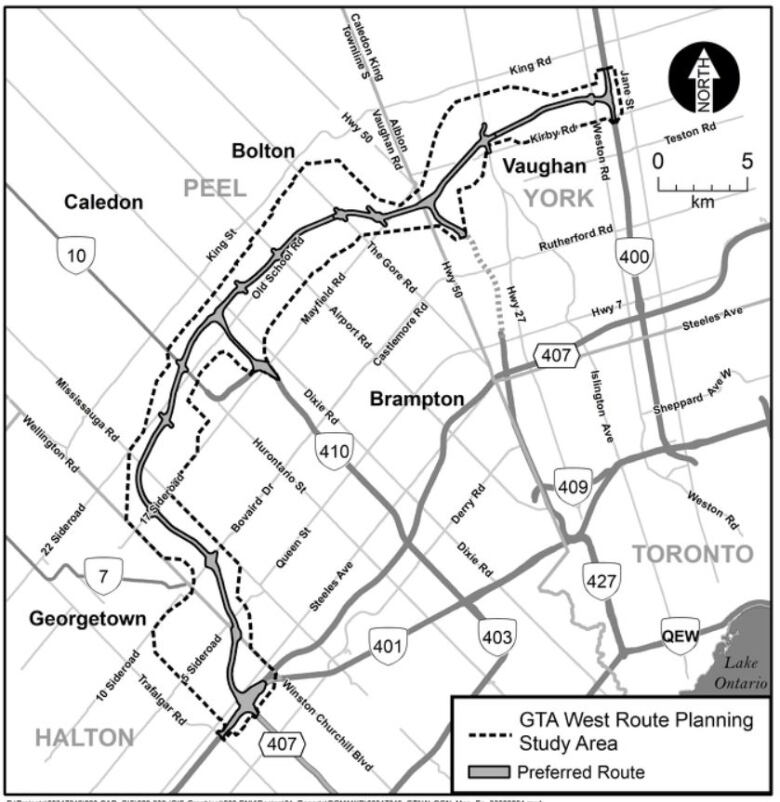Highway 413 locks Ontario into a high-carbon future, says Environmental Defence
Research projects highway would add 17.4M tonnes of emissions by 2050

An environmental group is calling a controversial plan to build a 400-series highway through the northwestern GTAa "sprawl accelerator" that would driveOntario even further away from its climate targets.
Research released Wednesday by Environmental Defence suggests that if Highway 413 is built, it could lead to 17.4 million extra tonnes of greenhouse gas emissions from vehicles by 2050.
"Think about that date, 2050. That's when scientists tell us we need to be at net-zero emissions," said Sarah Buchanan, the group's Ontario climate program manager.
"17.4 million tonnes of emissions definitely doesn't sound like net-zero to me."
For context, in 2018, transportation in the Greater Toronto and Hamilton Areaproduced just over 19 million tonnes of emissions one third of all region-wide emissions.
The highway, also called the GTA west corridor, is a 59-kilometre road set to run through Vaughan, Caledon, Brampton and Halton Hills, connecting Highway 400 with the Highway 401/407 interchange.
LISTEN | Supporters say Highway 413 will ease congestion, but critics say it will actually make it worse

Buchanan saysthe research they commissioned found that on top of vehicle-related emissions, the highway would also result in 1.4 billion dollars in damages by 2050, both through health care for people affected by pollution, and through damage to local ecology.
"Things like health impacts really need to be top of mind and, frankly, aren't right now in this decision making process," she said.
Congestion and a growing population
A decades-old idea that was abandoned by Kathleen Wynne's government and then resurrected under Premier Doug Ford, Highway 413 has been the target of significant criticism in the region.
A number of councils, including Toronto, Mississauga, Orangeville, and Halton Hills, have all passed motions voicing their opposition.
The province, meanwhile, has maintained that the highway is necessary to serve a rapidly growing population and take the pressure off congested roads.

A spokesperson for the Ministry of Transportation told CBCToronto that they are now in stage two of their environmental assessment, with built-in opportunities for public input and review later this year. The final report is expected to go to the environment ministry in late 2022.
The spokesperson also says that active transportation elements, such as over / underpasses for cyclists on provincial routes, and features like carpool lots and electric vehicle charging stations are being considered.
Environmental Defence's research made separate emissions projections based on Canada reaching its electric vehicle goals, noting that even in that best-case scenario, with more electric cars, Highway 413 would still result in 13 million tonnes of added emissions.
the group'sreport also argues that Highway 413 will not improve congestion, basing itsresearch instead on the idea that a highway will add new cars to the roads rather than spread out the number of people currently driving.
"When you build new highway infrastructure, more people simply decide to drive and fill up that road space," said Buchanan, describing a concept known as "induced demand" or "induced traffic."
'Clean sweep' of support for federal environmental assessment
Wednesday's report ends with a call to look at other ways to move people in the region, especially by expanding public transit and encouragingtrucks to take Highway 407, freeing up space on other highways.
Other environmental groups have also been sounding the alarm on the project this month.
Last week, a group of 59 scientists wrote a letter to federalEnvironment MinisterJonathan Wilkinsonrequesting that the federal government perform itsown environmental assessment.
"Emissions from transportation are the largest and fastest-growing source of GHGs [greenhouse gas emissions] in Ontario," the letter reads.
"A new 400-series highway which will incentivize car-use will make the climate crisis worse."

Buchanan says there's been clear support for a separatefederal assessment at a local level as well.
"We definitely have a clean sweep of every single local and regional government supporting this request," she said.
The province says Ottawa is expected to make a decision about whether to conduct its own assessment in early May.
Meanwhile, Buchanan says she was heartened to see no money allocated to Highway 413 in last month's provincial budget.
"We don't really know where the ministry is at on this decision," she said.
"We hope to hear soon that they've decided that based on the evidence at hand, and the significant public outcry that they will be cancelling the highway."












_(720p).jpg)


 OFFICIAL HD MUSIC VIDEO.jpg)
.jpg)



























































































